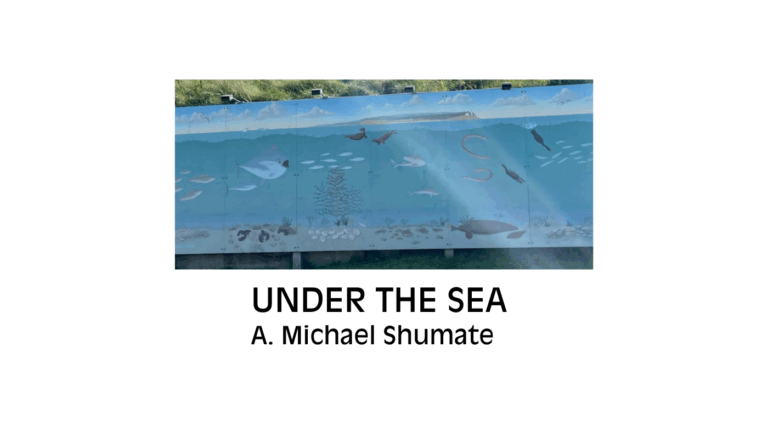‘Under the Sea‘, by artist A. Michael Shumate, is available to view at 8 Water St, courtesy of the Three Rivers Art Trail!
1 Top Atlantic Cod Gadus morhua
(18” to 22”, 3 to 25lbs) Canadian cod was prized by Europeans since the 1500s. Once severely overfished an endangered, cod fishing has been regulated since the 70s and has responded well, but still needs monitoring.
1 Bottom Snow Crab Chionecetes opilio
(5” wide body and 44” legspan) The second most valuable fishery export, mostly males are harvested, being more than twice the size of females. Both genders are reddish just after molting, turning greenish as their shells mature.
2 Top Bluefin Tuna Thunnus thynnus
(Up to 10 feet, 1400 lbs) PEI tuna was born in the Gulf of Mexico and spends part of its year in the Brazilian waters. Bluefin is bought for sushi, not canned tuna (that’s mostly Albacore).
2 Bottom American Lobster Homarus americanus
(Up to 25” & 40 lbs) Lobsters vary in colour, usually mottled blacks, browns and greens with only traces of orange and red; they only turn red when cooked.
3 Top Atlantic Mackerel Scomber scombrus
(12”, 1.6lbs) Mackerel swim in schools and can live as long as 20 years and grow up to 19 inches. They have lower levels of Mercury than some other seafoods.
3 Bottom Sea Scallop Placopecten magellanicus
(Typically 4-5”, up to 8”) Inside their shell perimeter scallops have about 100 primitive eyes. They don’t have focused vision but see shadows of predators. Oversize abductor muscles (the meat we eat) let it rapidly open and close its shell, to actively swim.
4 Top Spiny Dogfish Squalus acanthias
(33”, 6-10lbs) Spiny dogfish are small, true sharks in most temperate coastal waters around the world. It has more varied purposes than any other Canadian fish: its oils are used for industrial lubricants, lighting fuel, and vitamin A; it’s flesh is used for fertilizer, food and fish meal, and for the shark fin trade. Now threatened due to overfishing.
4 Bottom Atlantic Rock Crab Cancer irroratus
(5” wide body) Rock crab live in a wide range of depth from over the low tide line to as low as 2,600 feet deep including areas where lobster live. They live for six years before being marketable size.
5 Top American Eel Anguilla rostrata
(Females to 41”, males to 24”) Although they look like snakes, eels are true fishes. They spawn in the open sea and the young return to freshwater rivers to grow up for several years.
5 Bottom Atlantic Halibut Hippoglossus hippoglossus
(60”, 200lbs) Halibut looks like a giant flounder and is found in the Atlantic from Virginia to the Arctic Circle. They are popular as a commercial catch as well as a game fish.
6 Top Herring Clupea harengus
(8-10”) Herring are among the most abundant fish in the seas and swim in large schools swimming with their mouths open to feed on phytoplankton and zooplankton. They are exported fish, smoked, marinated, pickled, or canned as sardines their roe is sold to Japan.
6 Bottom American Oyster Crassotrea virginica
(upto 10”) The American oyster is found from the southern Gulf of St. Lawrence to the Gulf of Mexico. They spend most of their lives in a fixed location. Oyster’s are born male and then about half change to become female.


